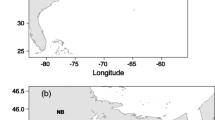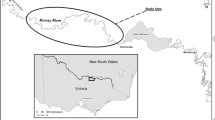Abstract
Many wetlands undergo seasonal cycles in precipitation and water depth.This environmental seasonality is echoed in patterns of production of fishbiomass, which, in turn, influence the phenology of other components of thefood web, including wading birds. Human activities, such as drainage orother alterations of the hydrology, can exacerbate these natural cycles andresult in detrimental stresses on fish production and the higher trophic levels dependent on this production. In this paper we model theseasonal pattern of fish production in a freshwater marsh, with specialreference to the Everglades/Big Cypress region of southern Florida.The model illustrates the temporal pattern of production through theyear, which can result in very high densities of fish at the end of ahydroperiod (period of flooding), aswell as the importance of ponds and other deep depressions, both as refugia and sinks during dry periods. The model predicts that: (1) there is an effective threshold in the length of the hydroperiod that must beexceeded for high fish-population densities to be produced, (2) large,piscivorous fishes do not appear tohave a major impact on smaller fishes in the marsh habitat, and (3) therecovery of small-fish populations in the marsh following a major droughtmay require up to a year. The last of these results is relevant toassessing anthropogenic impacts on marsh production, as these effectsmay increase the severity and frequency of droughts.
Similar content being viewed by others
References
Browder, J. A., S. Black, P. Schroeder, M. Brown, M. Newman, D. Cottrell & P. Pope, 1981. Perspectives on the ecological causes and effects of the variable algal composition of southern Everglades periphyton. Report T-643, South Florida Research Center, Homestead, Florida, 110 pp.
Browder, J. A., D. Cottrell, M. Brown, M. Newman, R. Edwards, J. Yuska, M. Browder & J. Krakoski, 1982. Biomass and primary production of macrophytes in periphyton habitats of the southern Everglades. Report T-662, South Florida Research Center, Homestead, Florida, 49 pp.
Browder, J. A., P. J. Gleason & D. R. Swift, 1994. Periphyton in the Everglades: Spatial variation, environmental correlates and ecological implications. In: S. M. Davis & J. C. Ogden (eds), Everglades: The Ecosystem and Its Restoration, pp. 379–418. St. Lucie Press, Delray Beach, Florida.
Fennema, R. J., C. J. Neidrauer, R. A. Johnson, T. K. MacVicar & W. A. Perkins, 1994. A computer model to simulate natural Everglades hydrology. In: S. M. Davis & J. C. Ogden (eds), Everglades: The Ecosystem and Its Restoration, pp. 249–289. St. Lucie Press, Delray Beach, Florida.
Fleming, D. M., W. F. Wolff & D. L. DeAngelis, 1994. Importance of landscape heterogeneity to wood storks in Florida Everglades. Environmental Management 18: 743–757.
Hinrichson, D, 1995. Waterworld. The Amicus Journal 17: 23–27.
Loftus, W. F. & A. M. Eklund, 1994. Long-term dynamics of an Everglades small-fish assemblage. In: S. M. Davis & J. C. Ogden (eds), Everglades: The Ecosystem and Its Restoration, pp. 461–483. St. Lucie Press, Delray Beach, Florida.
Loftus, W. F., R. A. Johnson & G. Anderson, 1992. Ecological impacts of the reduction of groundwater levels in the rocklands’. In: J. A. Stafford & J. J. Simon (eds), Proceedings of the First International Conference on Groundwater Ecology, pp. 199–208. American Water Resources Association, Bethesda, Maryland.
Loftus, W. F. & J. A. Kushlan, 1987. Freshwater fishes of southern Florida. Bull. Fla. State Mus. Biol. Sci. 31: 147–344.
Ogden, J. C., 1994. A comparison of wading bird nesting colony dynamics (1931–1946 and 1974–1989) as an indication of ecosystem conditions in the southern Everglades. In: S. M. Davis & J. C. Ogden (eds), Everglades: The Ecosystem and Its Restoration, pp. 533–570. St. Lucie Press, Delray Beach, Florida.
Author information
Authors and Affiliations
Rights and permissions
About this article
Cite this article
DeAngelis, D.L., Loftus, W.F., Trexler, J.C. et al. Modeling fish dynamics and effects of stress in a hydrologically pulsed ecosystem. Journal of Aquatic Ecosystem Stress and Recovery 6, 1–13 (1997). https://doi.org/10.1023/A:1008228706210
Issue Date:
DOI: https://doi.org/10.1023/A:1008228706210




